
Since 2000, the role of the sensor is to detect the physical signal and then provide it to the upper layer for use, so it is a single MEMS and analog front end, doing some digital circuit signal processing, and then directly converting the physical signal into an electrical signal to provide it, and the relative function is relatively single.
After a certain development, we can define its single hardware, integrate more algorithms and software functions, to do some customized configuration, integrate some richer functions, and even put a programmable processor inside to do algorithm integration, to achieve more functions.
Now, edge AI algorithms can also be integrated into small sensor products, because the processor power consumption is already very low, and the processing power can also realize the operation of AI algorithms. Therefore, in the whole process, the single hardware of the sensor slowly carries more tasks to do more intelligent application scenarios.
What is edge AI?
Traditional AI carries signal transmission, which transmits physical signals to the network through wireless or other means, and after the network receives signals from hundreds of thousands or even tens of thousands of sensors, it can model big data and provide some intelligent responses and intelligent strategies in the cloud.
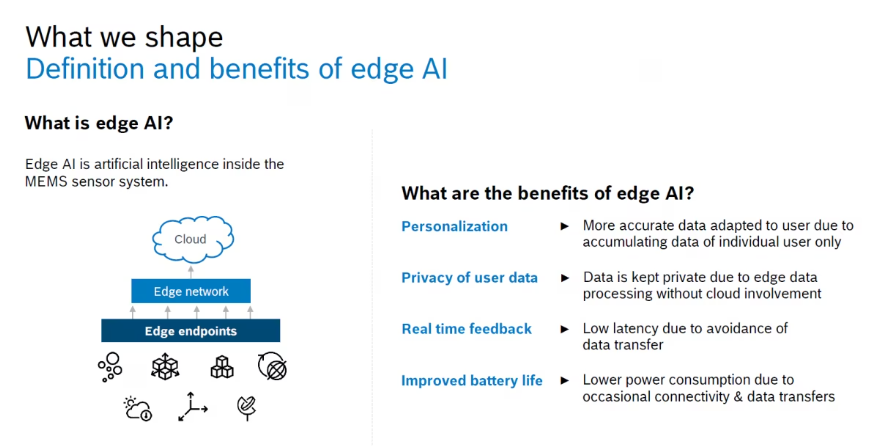 "In addition to the scheme, the edge AI algorithm can also be integrated into the sensor body, because the sensor can achieve this action as long as it integrates an ultra-low power processor."
"In addition to the scheme, the edge AI algorithm can also be integrated into the sensor body, because the sensor can achieve this action as long as it integrates an ultra-low power processor."
Benefits of integrating AI algorithms into devices
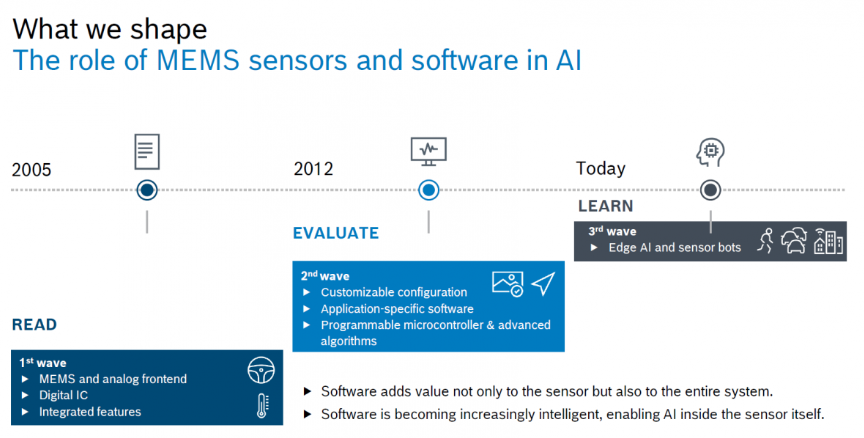
First, customization or personalization can be done at the device side. The requirements are different, and adapting to each user allows the sensor recognition accuracy to be adapted to each individual user.
Second, the sensor data does not need to be uploaded to the cloud, only exists in the device itself, or even inside the sensor. This ensures the security of sensor data, or the security of user data.
Third, real-time response, faster speed. There is no need to upload data to the cloud and then feed it back to the device, and it responds directly to the device.
Fourth, further reduce the power consumption of the device to extend the service life or daily use time of the battery.
Case sharing
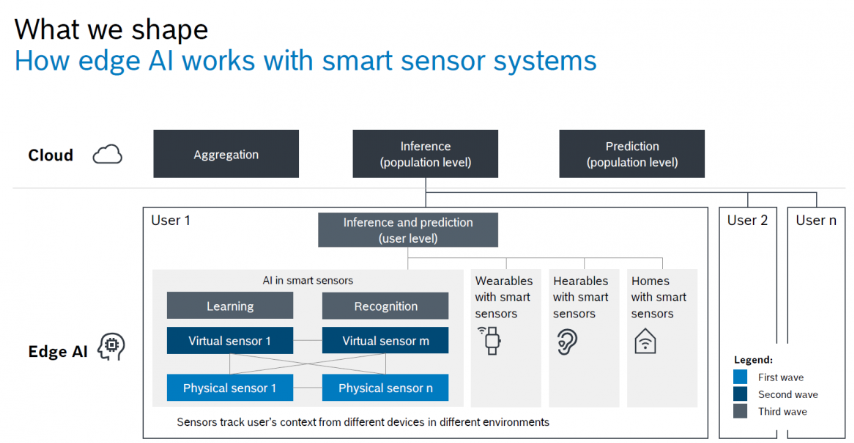
BHI380 sensor
Bosch BHI380(Naming rules: B stands for Bosch, H stands for hub, I stands for ACC and gyroscope two-in-one sensor) The size of the sensor is very small, so it can be used in mobile phones, watches, TWS headphones and other electronic products.
According to reports, the key advantages of the BHI380 sensor are:
Compact size, easier to integrate into various consumer electronics products; Power consumption is very low, because it integrates an ultra-low power processor, which ensures that the power consumption is below one milliampere when the data is fusing, reaching the microampere level. Through the built-in processor, it integrates some basic functions, such as integrating some AI algorithms. Users can perform secondary development according to the resources provided by Bosch and integrate their own algorithms to obtain higher scalability.
BHI380 sensor application scenarios:
One is the 3D sound that is now the most common in TWS headphones. Its principle is to detect when the user's head is rotating, the corresponding sound scene, or the user hears the sound, its sound position is unchanged, so when the user turns the head, the ear hears a stereo effect, which is based on the gyroscope to detect the head rotation Angle to achieve.
The second is gesture recognition or action recognition. For example, in walking, cycling, running, or in a car, high-speed rail, plane, these scenes can be identified by sensor data fusion.
The third is human-computer interaction.
The fourth is PDR. PDR is walking navigation, because now basically everyone has a smart watch or smart phone, which can record motion trajectory based on ACC and gyroscope data combined with Bosch's algorithm. This record does not require GPS participation, including indoors, such as in the mall, there is no GPS signal, but there may be some internal maps, which can be combined with the internal map of the mall for path planning.
The fifth is the AI fitness related record, or the tracking of fitness actions, including the algorithm of swimming posture.
According to reports, the Bosch sensor BHI380 has integrated some AI-related motion monitoring algorithms, and users can define some fitness actions in the daily use process, or use internal actions. Users can switch seamlessly, without the need to interfere with the watch, or need to do different fitness movements, do not do specific Settings on the watch. The device can automatically detect what action the user is currently doing and how many times.
Second, the power consumption of the device is 54% lower than that of the previous generation, which is very suitable for wearable devices.
The third is the integrated headset to detect the user's head tracking and get a stereo effect.
This is personalization, which is the core of AI algorithms. In addition to a dozen embedded fitness actions, users can define new fitness or any other action, which is the typical learning ability of AI.
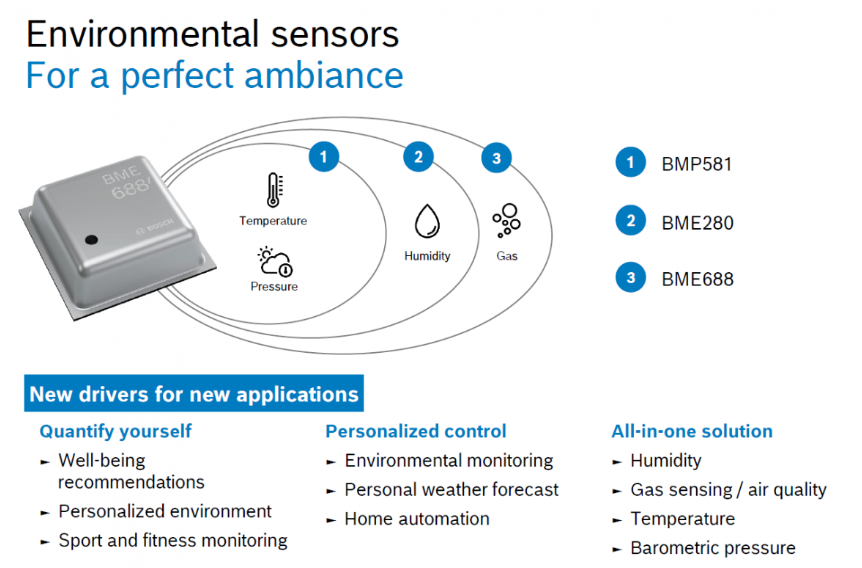
BME 688 4-in-1 sensor
BME 688 is Bosch's latest 4-in-1 environmental sensor, and it is also the world's smallest 4-in-1 sensor, which integrates temperature, pressure, humidity, and gas. Based on this environmental sensor, it can provide users with a microenvironment monitoring, and even do some weather forecasts of the microenvironment, as well as the linkage of smart homes.
How does this sensor implement AI capabilities?
This sensor has no further integrated controller or processor, so Bosch provides an AI learning development tool through the PC side, and users can do some customization based on this tool, or application scenario customization.
According to the case introduction, because BME688 can detect different gases, mainly VOC gases, how to distinguish the gases? In the first step, the user defines his own gas type, for example, he wants to detect the smell of a certain kind of coffee, he can based on the target gas of coffee, let the sensor to collect the signal of the target gas. After data collection, there is a corresponding simplified tool on the PC side, which allows users to capture data characteristics based on the collected sensor signals of the target gas. After the data features are captured, the tool is combined to generate a data model to identify the target gas. Finally, through the generated model, integrated into the customer algorithm, it can be combined with the physical signal of the sensor to do functional detection in real application scenarios.
VOC gas applications are particularly wide, such as the detection of forest wildfires, the detection of harmful gases, the detection of baby diapers, the detection of food freshness in the refrigerator, and even the detection of outdoor air index.
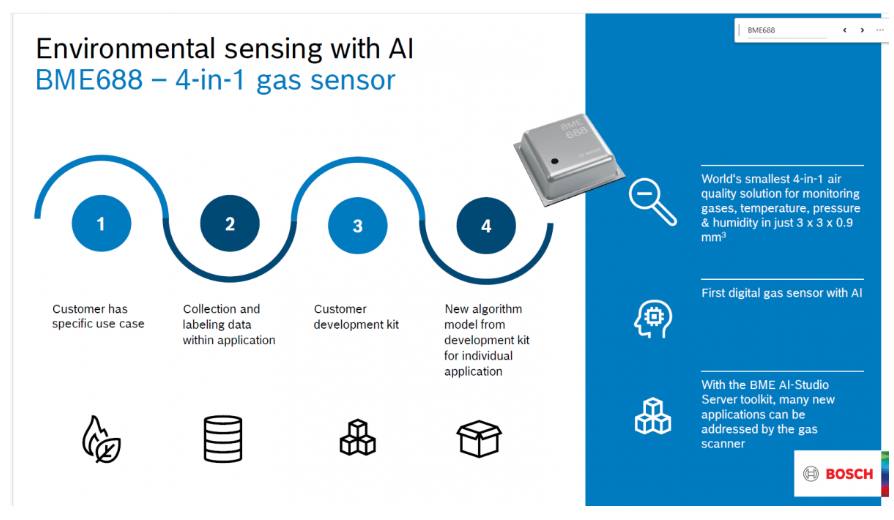
BME688 works by heating the metal oxide inside the sensor to produce a reduction reaction with the target gas, and its reduction reaction characteristics are different at different temperature points. Therefore, by collecting multiple temperature points and corresponding resistance values of the reduction reaction, the characteristics can be captured, and the distinctions can be made after the capture. For example, there are three volatile gases, which capture different characteristics, so you can quickly model the characteristics through the resistance value reported by the sensor at different temperature points.
Air pressure sensor BMP581
Because the barometer is the standard device in the mobile phone in North America, because the mobile phone operator in the region requires that all mobile phones must know the coordinates of the alarm when making an alarm call, which is identified by the barometer.
Here is an actual data collection, on the left are the different floors, the changes in the barometer are obvious, and on the right are the changes in the barometer collected while walking the stairs. The blue is the latest BMP 581 data, walking to each step, the barometer data changes with the step is one-to-one. It can be shown that its sensor noise and data are very accurate.
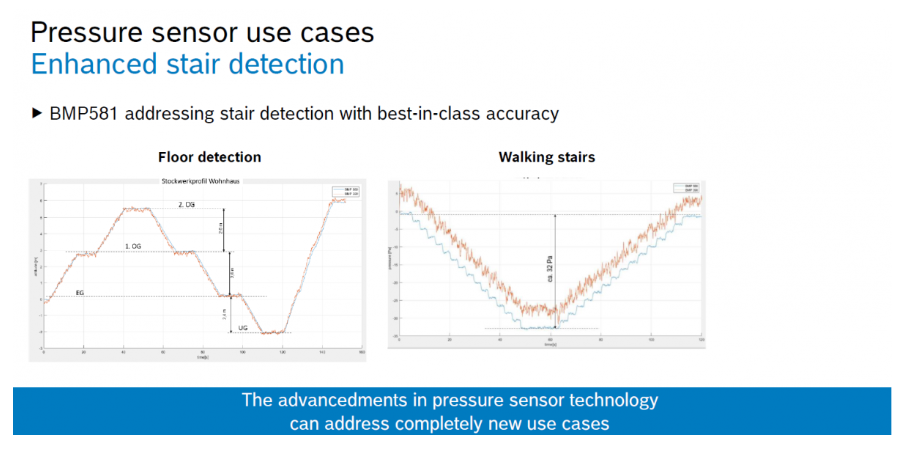
In ear wear products or wearable products, there are also some typical scenes, such as the user wearing smart headphones, when doing push-ups, the barometer can detect the height change when the user is sticking to the ground or supporting the body to identify how many push-ups the user has done.
The same is true when the user is doing a pull-up, the difference in height between the user's stretching and the full straightening of the arms can be detected, and the barometer can quickly identify the user's stretching motion.
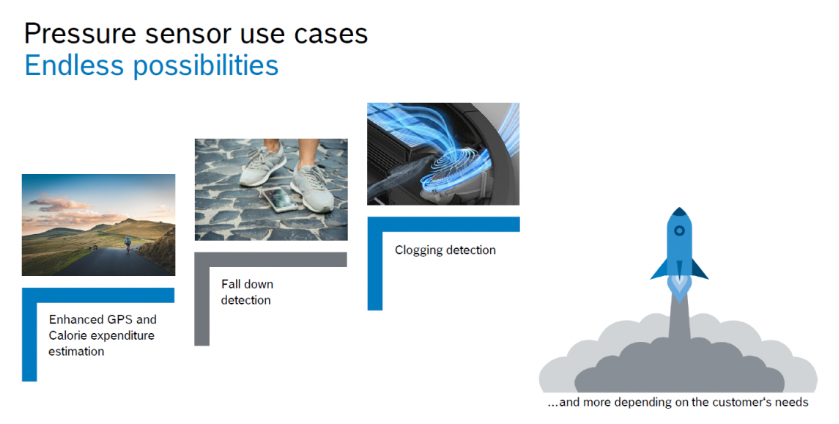
Heisener Electronic is a famous international One Stop Purchasing Service Provider of Electronic Components. Based on the concept of Customer-orientation and Innovation, a good process control system, professional management team, advanced inventory management technology, we can provide one-stop electronic component supporting services that Heisener is the preferred partner for all the enterprises and research institutions.
